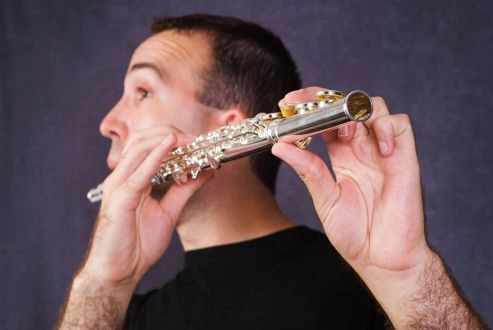As with most instruments, flutes are catered to suit right-handed individuals. Some wooden flutes are symmetrical so that they can be played ambidextrously. However, as you move on to other wind instruments, the options for left-handed individuals become pretty bleak. But can a left handed person play the flute and if so how? The golden word is “adapt”. Unfortunately, due to the scarce availability of left-hand flutes, most left-handed individuals have no option but to play the instrument right-handed. It is not that left handed flutes don’t exist at all, it’s just that they’re really hard to come by.
Table of Contents
Are Flutes Right or Left Handed?

Technically, flutes are neither right nor left-handed simply because flutists use both hands to play the instrument, though it is placed to the right. Thus, when it comes to symmetrical six-hole flutes with inline finger holes and no keys, they can be played on both sides, regardless of whether you are a left or right-handed player.
The same, however, cannot be said for orchestral flutes with keys and the ‘Offset G’ key. In such flutes, it becomes evident whether it is meant to be played on the right or left side. Reputable brands widely produce right-handed orchestral flutes. As for left-handed flutes, you would have to make it custom or buy one made by Viento.
Do They Make Left Handed Flutes?

The short answer is yes. However, it is not as simple as you may think and it is not as easy as buying a left handed guitar. For example, if you are on the lookout for a six-hole flute with inline finger holes and no keys, you would have to ensure that the flute embouchure was made so that it can be played both right and left-handed. Unfortunately, most flutes come with asymmetrical embouchures, and symmetrical ones come few and far between. In such a case, the best and sometimes only option is to get it made custom, which comes with a hefty price tag.
As for flutes with keys, head joints, and the like, you would have to place a custom order for it. The other option is to buy it from the one company that makes left-handed concert flutes of serialized models suitable for beginners to intermediate flutists and teachers who like to teach their students how to play the flute by playing a mirrored version of the instrument.
Disadvantages of Playing Flute Left Handed
If you choose to play the flute left-handed when you first start a wind instrument, you will get used to a certain finger positioning. If you later want to try your hand at another wind instrument, left-handed ones will be harder to find. Eventually, you might find yourself playing the flute right-handed, especially if you aren’t willing to dent your wallet with a custom instrument.
Changing the way you play the instrument later will be complicated, as you would have to unlearn the way you used to play and learn to play it right-handed. This may discourage you from continuing to play the flute. To avoid such a situation, it is more advantageous to play the flute right-handed right from the beginning. In fact, most left-handed flutists prefer to play right-handed as the dexterity of their dominant hand allows them to play the instrument with relatively more ease than right-handed players. This can make it a good instrument for left-handed people to play.
Another disadvantage is if you want to play in an orchestra setting, you’d have to be accommodated in the seating so as not to get in the way of other players. This is also an issue for left-handed violinists playing classical music even though it’s more common to find left-handers playing violin on a left-handed instrument in a folk band or as a soloist. Vice versa, a right-handed French Horn would be just as awkward to play because regular French horns are left-handed!
Advantages of Playing Ambidextrously
Firstly, if you are experiencing posture difficulties that cause you pain when playing the flute right-handed, switching sides may relieve you of the pain and tension. Secondly, playing the flute requires dexterity with both hands, just like playing piano if you’re left-handed. Changing sides occasionally once you are an experienced player might improve this dexterity and coordination. Thirdly, if you are a teacher, playing the mirrored version of the instrument played by your student would make the learning process more straightforward as the student has to mirror the teacher.
As a flutist, you should have the option to choose to play the flute right or left-handed; unfortunately, due to the scarcity of left-handed flutes, this choice is fairly bleak. Companies that manufacture flutes should pay heed to this disparity and make left-handed flutes readily available as well, especially since such flutes come with advantages of their own.
How to Hold a Flute Left Handed
To put it simply, if you’re a left handed flute player, holding a flute left-handed is just the mirrored version of holding it right-handed.
- Posture
Before dealing with the flute itself, ensure that you have proper posture. If not, not only will it affect your playing, but it may also cause neck, back, or shoulder pain. Alleviate your spine from any tension and sit or stand straight. Hunching is a strict no-no as it prevents you from taking in full breaths required to play the instrument.
- Placement of your right hand
Now coming to the flute. First, place your right hand on the flute closer to the embouchure. Your thumb should be on the first key located at the bottom, and the rest of your fingers should curve around the flute naturally. The weight of the instrument falls on this hand, so make sure you have a firm grip. The index finger should be on the second key, the middle finger on the fourth, the ring finger on the fifth, and the pinky should gently rest on the side key.
- Placement of your left hand
Place your left thumb on the flute close to the opposite end of the flute, i.e., the foot joint. Then, place your index to ring fingers on the three buttons near the foot joint. Finally, your pinky finger is placed on the first key on the foot joint. As you place your fingers, remember that your left palm must face the front, i.e., the opposite direction of your right palm.
Now that you have learned the placements of your hands, focus on how you hold the flute. Remember to hold the instrument perpendicular to you, in other words, parallel to the ground. At this position, the airflow is optimal, and it results in a clear sound. Beginners often let their elbows droop, which makes the flute slant downwards but this results in a squeaky sound.
Left Handed Flute Makers
When thinking of left-handed flutes, only one company comes to mind – Viento. Viento is a German flute-making company that is the first and one of the only flute makers to supply serialized models of left-handed concert flutes. If you want to know more about Viento or check out their flutes, head on to their website for North America or Europe.
